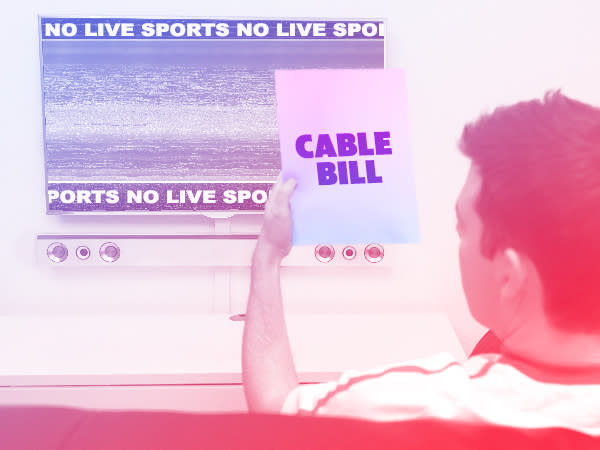If leagues aren’t playing games, why should cable consumers still be paying them?
Times are tight in quarantine. Money’s scarce, jobs are vanishing. But you’re still throwing a few bucks at your local McDonald’s even though it’s closed, right? Still sending a few dollars a month to Delta even though your flight got cancelled? Black Widow didn’t show up in theaters last weekend, but you definitely still sent the cost of a movie ticket to Disney anyway, right?
No? Well, you’re still paying for sports on cable, month after game-free month. And as the lockdown stretches deep into its third month, with no real end in sight, it’s about time to ask how much longer we ought to be paying for games that aren’t taking place.
At this moment, the MLB players union is considering a proposal that would bring back baseball, with a potential projected start date of July 4. Come on, how much more American could that be? It’s a great theory, but if it falls through, we’re looking at many more weeks or months without a wide swath of the sporting landscape.
Let’s be clear: Players are under absolutely no obligation to return to the field. If they don’t feel it’s the right time from a health perspective — and there’s plenty of evidence to back them up — “our entertainment” isn’t enough of a justification to haul them back.
By the same token, though, we’re paying for services we’re not getting. And while that’s fine and good if you’re looking to support your local pizzeria or coffee shop, it’s a different animal when we’re talking about multinational, multi-zero entities like MLB, the NBA and other leagues. In boom times, leagues and their media mouthpieces love to trumpet that franchises have values in excess of $1 billion, even $2 billion. And right now, they’re holding money for services not provided.
The knot of contracts, obligations, outlays and receivables is a complex one, but it boils down to this. The prize is the right to broadcast games; the leagues own those rights, and they know you want to watch games. So the leagues charge the networks, which in turn charge cable companies, which in turn charge you.
The average American household with cable pays about $20 a month in sports-related fees, according to KilltheCableBill.com, and with 86.5 million households that means $1.73 billion a month in money paid to cable companies for sports rights … even though we haven’t had sports for two months.

Granted, live sports aren’t the only reason we have ESPN in our lineup. The NFL draft and “The Last Dance” have helped keep sports fans sane during the pandemic. But we don’t sign up for, say, the MLB Network for a steady diet of remember-when replays. There are only so many times you can watch World Series games from the ‘80s, after all.
There’s plenty of precedent at work across the American economic landscape. Car insurance companies are giving rebates to policyholders because cars have sat unused for weeks. Airlines have waived change fees — regardless of what you think of them, they’re still a source of revenue — as uncertainty has gripped the industry. Other companies are waiving delivery and shipping fees for consumers.
New York Attorney General Letitia James has stepped into the fray, calling on the cable companies to cut their fees. She termed it “grossly unfair that cable and satellite television providers would continue to charge fees for services they are not even providing. These companies must step up and immediately propose plans to cut charges and provide much-needed financial relief.”
That’s a powerful sentiment, but it doesn’t track far enough back upstream. Cable companies have already paid rights fees to networks. This is the equivalent of demanding your delivery driver reimburse you for a pizza that was burnt at the store.
National sports leagues and networks accrue revenue in part by offloading costs onto consumers. Dinging viewers with a small charge on their cable bill might not seem like much over a month, but what about two months? Three? Four? If baseball comes back in mid-July, that’s four months without sports. Suddenly those little charges start to add up, particularly for households struggling with lost jobs. Twenty bucks a month might not be much, but after a few months, we’re getting into week’s-worth-of-groceries territory for some households.
What clarifies the situation even more is the fact that teams are cutting themselves a break on their financial obligations. For instance, baseball teams won’t be on the hook for paying players for the full season, but only a prorated share based on how many games are actually played. The NBA has begun withholding money from players’ paychecks in anticipation of a partial or total loss of the season. In the owners’ eyes, no games equals no revenue and thus no obligation to pay salaries.
With that in mind, it’s fair to wonder: If leagues aren’t playing games, why should cable consumers still be paying them?
More from Yahoo Sports:
